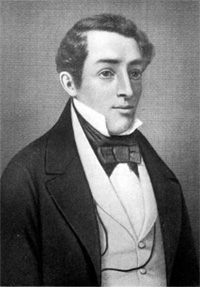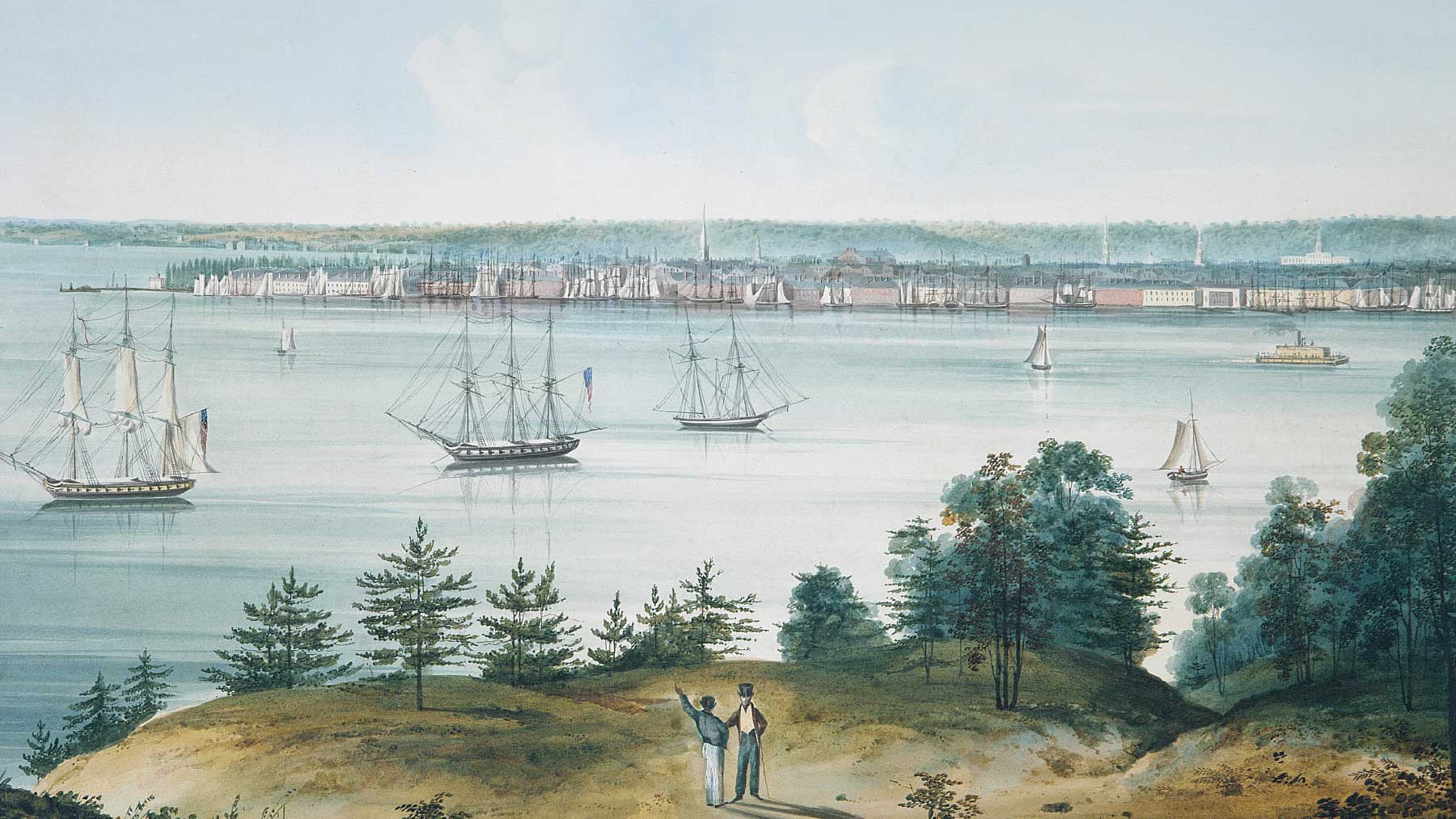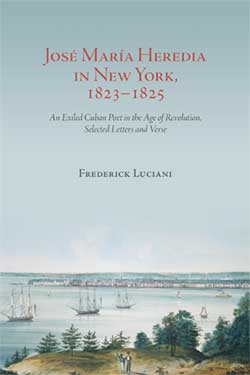From José María Heredia in New York, 1823–1825: An Exiled Cuban poet in the Age of Revolution, Selected Letters and Verse (SUNY Press); edited, translated, and with an introduction by Professor of Romance Languages and Literatures and Africana and Latin American Studies Frederick Luciani

José Maria Heredia (Cuba 1803–Mexico 1839) was a true child of the Age of Revolution, and his short and eventful life was marked decisively by the upheavals on the American continent as new republics struggled to emerge from the old colonial order. He was born in Santiago de Cuba on December 31, 1803; being born there was itself a consequence of revolution. His parents, José Francisco Heredia y Mieses and María de la Merced Heredia y Campuzano, were members of the same extended family of landowners in the island colony of Santo Domingo; the family traced its American roots to the Spanish conquistador Pedro de Heredia. In the wake of the Treaty of Basel, which conceded the Spanish portion of Hispaniola to France in 1795, José Francisco and María de la Merced, like many others of their race and class, fled Santo Domingo before the invading forces of Toussaint Louverture, fearing that the violence of the Haitian Revolution might engulf the whole island…
The year 1820 found the Heredia family in Mexico, where José Francisco occupied a Spanish government post; when he died suddenly, his wife and children returned to Cuba. The family settled in Matanzas, a small coastal city and provincial capital… In Havana, José María finished the study of law; in June of 1823 he was awarded his degree, and he prepared to take up practice.
By then, Heredia was gaining attention within his circle and beyond as a gifted poet. His early compositions give a sense of his amorous infatuations and political idealism, and his adaptations of French and Latin works suggest the scope of his erudition and a desire to hone his talent by imitating literary models. A few of these early works show that, although he was barely more than an adolescent, Heredia was approaching full command of his art. His poem “En el teocalli de Cholula,” begun in Mexico when he was only sixteen, is a striking example. A meditation upon the ruins of a pre-Hispanic temple, it is considered among Heredia’s most accomplished works. It contains the elements that distinguish his best poetry: a precise observation of landscape, a sure handling of lexicon and meter, a sweeping historical vision, a stern moral sensibility, and an Americanist scope that transcends classical and European paradigms.
Heredia endured the rough passage north bundled in the coat that the Galaxy’s captain loaned him.
Given his ideals and his social environment, perhaps it was inevitable that Heredia would be caught up in the pro-independence agitation then sweeping Cuba. In July 1823, government authorities became aware of an islandwide conspiracy with masonic affiliations known as the Soles y Rayos de Bolívar, whose aim was to foment armed rebellion against Spanish rule. More than 600 individuals across the island were implicated in the plot. Heredia had been active in the Matanzas cell of the Soles, known as the Caballeros Racionales. In a bid for leniency, three fellow members of the Caballeros denounced him as an important figure in the group, and in early November an order was issued for his arrest. But Heredia had gone into hiding; through the intercession of a young friend, Josefa (“Pepilla”) Arango, he found refuge on the Arango family plantation near Matanzas. After a week there, he slipped out of the island in disguise aboard the American ship Galaxy bound for Boston. His separation from Cuba, which would continue almost uninterrupted for the rest of his life, had begun.
Heredia endured the rough passage north bundled in the coat that the Galaxy’s captain loaned him. He reached a snowy Boston on December 4, 1823, and within a few days ran across fellow conspirators Luciano Ramos and Miguel María Caraballo, the first of what would be an expanding group of Cuban expatriates with whom he would share lodgings, travels, and adventures. The three young men soon moved to New York City, where Heredia would live for most of the rest of his 20 months in the United States.

Heredia’s struggles with English made securing employment in New York difficult. A monthly stipend that his Uncle Ignacio sent from Cuba kept him financially afloat, and toward the end of his stay he also obtained a salary, room, and board as a Spanish teacher at a private school in the city. His modest resources were sufficient to purchase books, to take advantage of cultural opportunities—years later he would recall a stirring performance of Richard III in New York — and for travels in the summer of 1824. Although relatively free of financial worries, Heredia still faced physical and psychological challenges. The northern winters aggravated his predisposition to consumptive illnesses; in the winter of 1825, his condition was grave. He worried for the well-being of his mother and sisters in Cuba. He felt bitterness over the betrayal he had suffered at the hands of fellow conspirators. He anxiously awaited the outcome of the judicial hearings on the island regarding the Soles y Rayos plot and the fate of those implicated in it. And he felt a certain cultural alienation in the United States coupled with fierce nostalgia for the land from which he had been torn — as destierro and desterrado, his words of choice for describing his situation, vigorously express.
Despite these difficulties, Heredia maintained an intense rhythm of intellectual activity during his months in New York; arguably, this was to be the most productive phase of his poetic career. Between November 1823 and September 1825, he composed such major works as “A Emilia,” “Placeres de la Melancolía,” and his signature work, “Niágara.” The last of these composed at the falls, and the aforementioned “En el teocalli de Cholula,” are the two poems that have secured Heredia an essential place in the canon of Spanish American literature. He expressed his civic sensibilities, shaped now by the experience of living in a free republic, in compositions like “A Washington,” perhaps composed at Mount Vernon. His translations into Spanish of Ossian, Alfieri, and others reflected his expanded readings in world literature, especially of authors associated with international Romanticism. Heredia kept up to date with literary and other topics through English-language publications like the North American Review, and he frequented New York’s publishing houses and booksellers. Crowning these months of literary activity, in the summer of 1825 Heredia published the first collection of his works: Poesias (New York: Behr and Kahl). It is not surprising that he was able to publish his poetry in Spanish in the United States; a vigorous, often politically charged Spanish-language press existed in Philadelphia and New York in the 1820s. Through [his friend] Domingo del Monte, copies of Heredia’s Poesías were to reach prominent readers and reviewers in the Spanish-speaking world, thus greatly expanding his literary reputation.
From “To Emilia”
— Luciani, pg. 177
Soon a brilliant dawn of liberty
Shall break against a cloudless Cuban sky.
And then, Emilia, I
With angry steel and vengeance armed shall be.
To you I shall return. In voice sublime,
A splendid hymn of triumph I shall sing.
And if the saber of the enemy
Should cut me down, at least
On foreign shores my body will not lie.
When maidens and the strong above me weep,
Their tears will reach me in my glorious grave,
And happy I will sleep.
The tenderness of all I will inspire,
And for my noble tomb a crown shall be
My sword of vengeance and my plaintive lyre.
In December 1824, Heredia received word that the legal case against the Soles y Rayos conspirators had been decided, and that he was among those sentenced to banishment from Cuba and exile to Spain. The doors to his homeland now officially closed, and with the prospect of continued difficulties living in the United States, Heredia left for Mexico in August 1825. The recently elected President Guadalupe Victoria — Mexico’s first after the adoption of the Constitution of 1824 — had offered Heredia a passport for his relocation to the new republic. En route, catching sight of Cuban shores from the rail of his ship, he penned another signature poem, “Himno del desterrado.” By mid-October, he was welcomed in Mexico City by Victoria, who would offer him his patronage during his four-year term in office. Heredia was given a position in the government’s Secretaría de Estado and would go on to serve in judicial posts in the State of Mexico, as a diputado in that state’s congress, and in significant positions in cultural and educational institutions. In 1827. Heredia married Jacoba Yáñez, the daughter of an old friend of his father in Mexico, and they began a family. His literary activity continued unabated, even if his most innovative and productive years as a poet already were behind him. His adaptations of French tragedies were performed in Mexico; he edited and published several literary journals, to which he contributed reviews, essays, stories, and poetry; and he advanced an ambitious intellectual project, his Lecciones de Historia Universal (1831). In 1832, an expanded and revised edition of his Poesías was published in two volumes in the city of Toluca.
In the 1830s, Heredia was caught up in the chaos that plagued Mexico after Victoria’s presidency: on more than one occasion he was compelled to take up arms in favor of one faction or another. It seems that he was subject to suspicion and persecution from all sides. As a Cuban, he still was technically a Spanish subject, and therefore some questioned his loyalty to the Mexican republic. As an outspoken defender of democratic liberalism and the rule of law, he ran afoul of many in this period of aggressive political opportunism in Mexico. Moreover, Heredia’s troubles with Spanish authorities in Cuba only worsened; he was accused of association with the Gran Legión del Águila Negra conspiracy of the late 1820s, another pro-Cuban independence plot linked to freemasonry and based in Mexico. This time the colonial government in Cuba sentenced Heredia to death and the confiscation of his possessions, which made his dream of a return to his native island all the more improbable. His placement in Mexican government and judicial posts at a young age did not endear him to all, and his career path was often blocked. This had serious financial consequences for Heredia and his growing family, as did the irregular payment of government salaries in situations of near-anarchy. His health was delicate, as was that of his wife, and the couple lost three of their six children to childhood diseases.
Heredia’s prospects for reunion with his mother and sisters brightened when the widow of Ferdinand VII, María Cristina de Borbón, acting as regent, issued an amnesty decree for Spanish political exiles. While the terms of the decree alone were not sufficient for Heredia to return to Cuba, they did inspire him to seek permission to do so. In 1836, through direct contact with the island’s governor, Captain General Miguel Tacón, Heredia was granted a two-month visit. Leaving Jacoba and their children in Mexico, Heredia arrived in Havana in November 1836 and stayed, mostly in Matanzas, until January 1837. Upon his return to Mexico, he faced continued difficulties: declining health, the loss of a government post because of a new requirement that its holders be native-born Mexicans, and the failure of the government to pay salaries owed to functionaries, leaving the Heredia family in even more dire financial straits. Heredia’s final months were spent scraping by, and on May 7, 1839, at age 35, he finally succumbed to the consumptive illness that had plagued him since his teens.
For Cubans of his and later generations, Heredia was the poet who first and most vividly expressed a sense of Cuban nationhood, linked indissolubly to the island’s landscapes and to the poet’s exilic condition. For it was from the distance of his destierro that Heredia evoked, in his imagination and from the depths of his ethical and political consciousness, a homeland that combined, in his words, “of the natural world, loveliness, / of the moral world, depravity.” The degree to which Heredia’s verses were an inspiration for pro-independence Cubans of his generation cannot be overstated.


